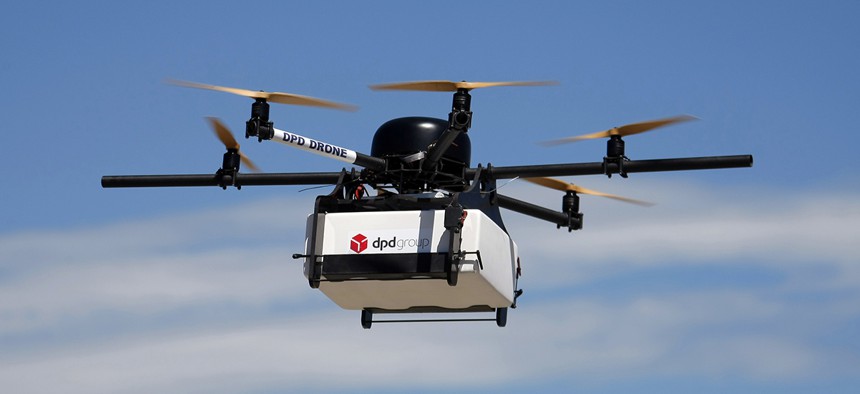With New Testing Rules, Will 2018 Finally Be the Year of the Drone?

Claude Paris/AP
The visual line-of-sight rule is perhaps the most important limitation to widespread commercial use of drones.
In Mao's China, the order of the day was to “let a thousand flowers bloom” (actually a misquote) but today the Chinese are more likely to say “let a thousand drones fly.” China's SF Express is one of the first companies in the country, and in the world, to deliver packages using drones, in what the company calls a “huge moment in drone development.”
The question for Americans, of course, is when we will get our version of a thousand drones overhead. To bring that day closer, President Donald Trump recently released an executive order asking aviation authorities to “further integrate” drones into the skies over the U.S. The order instructs officials to develop new guidelines “to promote the safe operation of unmanned aircraft systems (UAS) and enable the development of UAS technologies for use in agriculture, commerce, emergency management, human transportation, and other sectors.”
Indeed, 2018 could be the year of the drone. In 2017, drones earned their chops by coming to the aid of rescue services and insurance companies dealing with the aftermath of the devastating hurricanes in Florida, Texas and Puerto Rico. Aid groups used drones to assess damage, and insurance companies used them to process claims. It's clear that they are up to the job; now, the regulators have to be convinced.
Regulations in the United States have prevented the use of drones for anything beyond aerial observation, with the Federal Aviation Administration placing significant restrictions on drone operations. Those regulations—among them a requirement that drones always be within the line of sight of operators and that each drone has its own operator—need to be changed in order to enable operators to use drones on a commercial basis. In order for that to happen, though, drones need to be able to operate in a manner that will reassure regulators that they can relax the rules and allow drones to fly, even in the cities.
The vision that Amazon, Walmart and many other companies have for drones that can deliver packages in urban environments will require drones that will be able to navigate crowded urban airspaces safely—and once those drones are widely available, regulators will feel comfortable easing the rules that limit their use. Only then will we see a true “blooming” of the potential of drones—for package deliveries, aerial inspections and security, farming, and a thousand and one other uses that companies are already planning to use drones for.
The visual line-of-sight rule is perhaps the most important limitation to widespread commercial use of drones, but in order for the FAA to lift that rule, drones need to be able to navigate in a manner that will enable them to avoid hazards like rooftop antennas, birds and other drones. Another rule impeding the commercial use of drones is the single operator rule, which requires that each drone be operated by a single individual. That rule, too, needs to be adjusted, in order to enable companies like Amazon to deploy the fleets of drones they envisage dropping off packages at the homes of customers.
For those rules to be changed, drones need to be capable of autonomous navigation—and the way to do that is to load them up with technologies like machine vision, sensor tech, cameras and communication technology that will enable them to stay in touch with headquarters. With machine vision—technology that uses cameras to enable drones to electronically “see” what is around them—drones will be able to navigate crowded skies, avoiding direct hits and even near misses. Sensors will also contribute, ensuring that drones are able to detect obstacles. And with communication technology on board, operators will be able to lay out routes for drones, ensuring that, like airplanes, they each fly in their own air routes in a grid that allows each safe passage through the skies. Thus will drones come into their own, being used commercially for a wide variety of purposes that companies are preparing to use drones for but haven't been able to due to FAA rules.
The best part of all this is that these technologies exist right now. Machine vision is already used on military aircraft, missiles and other airborne craft, while sensors are used nowadays for everything from automated vacuum cleaners to helicopters. Grid technology to enable drones to fly in their own airspace has gotten a big boost in recent years from technology developed for autonomous vehicles. Unlike with automated vehicles, however, which will affect society in a profound manner, there's no need to “sell” society on the advantages of drones. Drones won't require any behavioral changes on the part of the people using them or benefiting from them. It's just a matter of time before drones are ready for commercial prime time—and until regulators realize that it's time to let drones bloom.
Louis Ziskin is the chief executive officer of DropIn.





